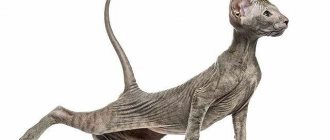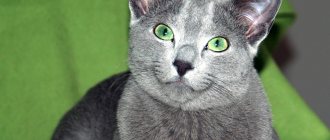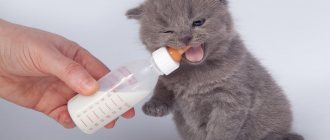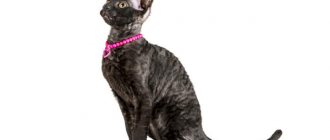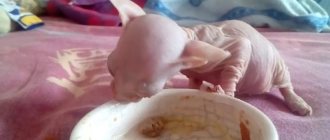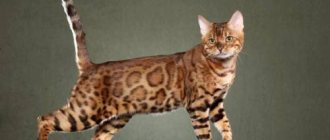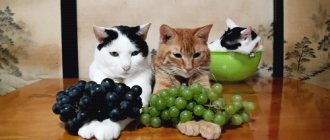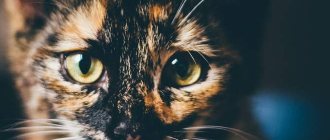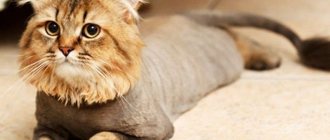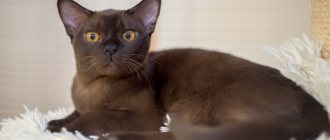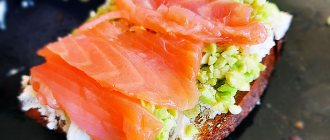What to feed your Persian at different stages of his life?
What to feed a Persian at different stages of its life is what worries the owners of Persian cats. Pets need to be taught proper nutrition from early childhood. As soon as they appear in the house. You need to correctly assess your own capabilities, consult with a veterinarian and the breeder from whom the animal was purchased. And feed it so that as the kitten grows up it acquires a truly luxurious coat, strong claws and teeth, without experiencing problems with digestion and health in general.
What to feed a Persian kitten for 2 months
Until two months of age, almost all Persian kittens are fed breast milk. But what to feed a Persian kitten at 2 months? In fact, everything is not as difficult as it might seem. During this period, the kitten should begin to be fed. And for complementary feeding, of course, you need to take only the freshest products, keeping in mind the delicate Persian stomach.
At this age, a baby Persian cat should eat at least 6 times a day. And he needs to be given porridge boiled in low-fat milk and half and half water. No salt sugar! Plus scalded frozen lean meat scraped off with a knife. You can give vegetable purees - freshly cooked and chopped or from baby food jars. Just a little bit - literally one finger at a time.
What to feed a Persian kitten at six months
What to feed Persian kittens at six months? First of all, you need to increase the portions. And the meat can not only be scraped and scalded, but also boiled. The main thing is that it is not greasy. You also need to reduce the number of feedings to 3-4 per day. And if you decide that your furry treasure will eat dry food, then it’s time to introduce him to it. And first, just soak the granules in chicken or beef broth. But milk and dairy products (except for low-fat cottage cheese) should disappear forever from the cat’s diet. But cream and sour cream should not appear there. But eggs may appear - those same quail ones. You can leave fermented unsweetened yoghurts. And there must be water. Plenty and freely available. Always fresh.
What to feed a Persian up to a year old
From 6 months to a year, the diet of a Persian kitten practically does not change. The weight of single servings only increases and the number of feedings decreases (to 2-3 per day). By the age of one year, a male cat of the Persian breed should be completely switched to an “adult” diet. If it is dry food, then only it is “premium class”, professional, from a well-known manufacturer. If it's canned, then canned. And if according to the formula “canned food + drying”, then the first is no more than 25% of the total diet. And one manufacturer.
Diet
Just like other pets, Persian cats should eat at approximately the same times. Although Persians are very gentle and vulnerable animals, they need to be taught discipline. The cat should have a single place for eating; it should not be taught to take tasty things from the hands of the owner.
The number and volume of servings directly depends on the age of the cat:
- up to one month – feeds on mother’s milk as needed;
- 1-2 months – up to 6 times a day;
- 2-4 months – the number of meals is reduced to 4-5 times;
- 4-6 months – the animal is transferred to three meals a day;
- from 10 months – can be switched to adult cat mode – 2 times a day.
The daily intake for a Persian baby is calculated according to the formula: 250 g per 1 kg of live weight. For an adult, this norm can increase by 100 g.
What to feed an adult Persian cat
Just like most other cats, Persians need to eat meat frequently. In their daily diet, the meat part should be at least 50-60%. The share of vegetables in the total volume should not be more than 30%, and cereals - more than 10-18%. The following group of products is included in the daily menu for natural feeding:
- Meat. The most beneficial benefits come from lean boiled or chopped raw meat - chicken (dietary low-fat parts, for example, brisket), rabbit, beef, veal, lamb.
- Offal. Pieces of raw cow stomach will be the most useful. Persians also love chicken kidneys and hearts. You should avoid chicken necks or bone sets.
- Fish. This product is not paramount for the Persian breed. You can feed your four-legged friend fish no more than once every two weeks. It is better to give preference to marine and low-fat varieties. It is generally better to avoid river fish.
- Dairy and fermented milk products. Persians consume kefir with great pleasure. The optimal percentage of fat content is 1%. You can also give cottage cheese; if desired, your pet can dilute it with a small amount of water or yogurt. Low-fat yogurt can also be given. But it’s better to avoid cow’s milk altogether. In Persian cats it often causes diarrhea and bloating.
- Vegetables. It is recommended to add zucchini, cauliflower, carrots, pumpkin, green beans, and beets to meat dishes.
- Eggs. Not all cats, including Persians, can cope with digesting chicken eggs. However, they are a source of protein necessary for the body. Therefore, quail eggs would be the best option. They can be given to cats both raw and boiled.
- Cereals. The most suitable from this group are rice, barley and buckwheat.
It is recommended to approach the choice of each product as responsibly as possible. Persians should only eat freshly prepared food. Given their sensitive digestive system, you should not leave “for tomorrow” what was not eaten on time.
What Persians can't do
Just like some other cat breeds, Persian cats cannot eat certain foods that are very familiar to people, but harmful to animals. It is strictly forbidden to feed Persians the following foods:
- fatty meats, especially pork, lamb, fatty parts of poultry – take a long time to digest and make it difficult for the liver;
- boiled-smoked products - sausages, sausages, smoked hams, etc.;
- eggplants contain substances that are toxic to animals;
- any spices and additives, including salt, mayonnaise, ketchup;
- tubular bones - can cause injuries to the digestive tract, get stuck in the throat or completely block the intestinal patency;
- onions and garlic - irritate the mucous membranes and cause fermentation;
- liver, boiled or raw;
- fatty sour cream and cream - cause digestive problems;
- sweets are also poisonous to animals.
It is also recommended to limit the amount of dairy products. Abuse of them can cause indigestion and bloating. Although fish is a tasty delicacy for animals, in excessive quantities it can harm the animal’s kidneys. To prevent possible complications, its use is limited to twice a week.
If the owner takes care of a healthy and balanced diet for the Persian cat, he will be able to enjoy his friendly company for many years. The thick and lush fur of representatives of the breed will please the eye only if the cat’s body has enough minerals and essential vitamins.
How to introduce complementary foods correctly
At one month of age, only 2 milk feedings are left, and new foods are offered at the remaining meals. During this period, you need to carefully monitor the baby’s well-being, as digestive problems are possible: loose stools or constipation, vomiting, an allergic reaction to some ingredient, etc. In order for the introduction of complementary foods to be successful, it is recommended to follow these rules:
- a new product is introduced at intervals of 3-4 days to monitor the reaction of the animal’s body;
- vegetables must be boiled; raw vegetables should not be given at an early age;
- It is not recommended to add spices or add salt to the kitten’s food;
- You should not combine natural food and industrial feed;
- Offer food according to package directions, i.e. The shape of dry granules or the consistency of wet food should be appropriate for the age of the kitten.
Unfamiliar products should be introduced gradually. So, on the first day you can offer only a pinch of a new ingredient, increasing the serving size daily.
Conditions of detention
These cats feel great when kept indoors and do not want to go outside. Moreover, due to weak immunity, walks are undesirable for them.
They are very attached to their owner and strive to spend as much time as possible with him. They react sensitively to moods and try to console and protect as best they can. They are calm and patient, do not get out of control, and usually easily tolerate children's games.
Cats caring for small kittens need special attention, as they may be torn between their desire to spend time with their owner and their maternal instincts.
It is advisable to purchase a house for your pet - it is important for cats to have a personal protected space. Please note that under no circumstances should you take your pet out of the house - only call or lure it in, without using force.
It is advisable to purchase a ceramic bowl. Glass and aluminum are less recommended. Plastic is harmful - it accumulates dirt and promotes the growth of bacteria. The cat's bowl should be washed after every meal, especially when using natural and commercial wet food.
New owners usually have a question about what to call a Persian cat.
The nickname should reflect the nobility of the breed, but at the same time be easy to pronounce and be harmonious. When deciding what to name your cat, pay attention to its appearance or habits.
The boy's kitten can be called Amber, Tiger, Sultan, Renoir. Suitable names for a girl are Perseus, Tutti, Iriska. You can also call the cat Vivien, Amanda, Louise.
Arguments against"
At the very beginning, you need to understand the difference in the diets of adults and recently born pets. The former eat less often, but in large portions, while the latter, on the contrary, eat every couple of hours, but little by little. But you shouldn’t make hasty conclusions that you can fill a bowl with food (the same thing that you feed large animals), put it under the kitten’s nose and wait for it to grow into a healthy and beautiful cat.
During the period of active growth, pets need high-calorie food, otherwise there will not be enough energy for either play or full development. Formed individuals do not need so many calories, so cat food has a relatively low nutritional value. Feeding your baby such food is fraught with delays in development and growth.
In addition, small animals need a large amount of macro- and microelements, as well as vitamins. Their deficiency provokes inhibition of development. The composition of cat food cannot boast of the required concentration.
In addition, the feeds also differ in the size of the granules. Adult felines can easily chew and swallow large pieces, but kittens simply run the risk of choking.
What is a trichobezoar
You can, of course, shave your cat like a poodle, choose food with a high amount of fiber, or set up a mini home garden or sprout grass for your pet. But today we will tell you about another way to combat trichobezoars - this is malt paste.
Malt in English means “malt”. Malt is grains (usually barley or other feed grains) that undergo fermentation during germination and release a substance that can break down starch into simple sugars - diastase. When yeast and sugar are added, they turn into alcohol. This property makes malt an indispensable product for breweries and wine production.
- However, in malt paste, malt is just a source of fiber, a sweetener and a flavor enhancer.
- Malt paste also contains vegetable oils and sometimes pre- and/or probiotics.
We suggest you read: Self-diagnosis of sores on rabbits’ feet
Cats really like the taste of malt extract. Plant coarse fibers stimulate intestinal motility, helping to move hairballs towards the “exit”. Thus, the ingested hair leaves the cat’s body naturally – easily and painlessly.
With regular use of malt paste, pets:
- stool is normalized;
- vomiting passes;
- appetite improves.
Some owners think that malt paste stimulates hair vomiting in pets - this is not true!
Natural food
Let us clarify that by natural food we mean specially prepared food for cats. You cannot give any cutlets, sausages, pasta or chicken legs to Persians from your table! Now we’ll talk about how to properly formulate a cat’s diet using natural nutrition.
The first thing a Persian cat should have on their daily menu is meat. Meat is a source of animal protein. In addition, cats cannot synthesize some important amino acids in their bodies: arginine and taurine. Without sufficient amounts of these amino acids, Persians' metabolism is disrupted, and the functions of some internal organs may change. Also, cats do not absorb carotene; they need a constant supply of vitamin A, which is found in animal proteins.
The meat in the Persian diet should be lean: chicken, turkey, beef, lamb, rabbit. You can give it boiled or raw (heavily frozen). Fish can appear on a cat’s menu no more than once every 2 weeks. Boiled sea fish, freed from bones, is best suited. If a cat has diseases of the urinary system, then fish is contraindicated for it.
What products besides meat does a natural diet include:
- vegetables (raw or boiled): carrots, cauliflower, zucchini, turnips, pumpkin, green beans;
- cereals (boiled): buckwheat, rice, pearl barley;
- skim cheese;
- low-fat fermented milk products: fermented baked milk, yogurt, kefir;
- quail eggs (raw) – 4-5 per week;
- low-fat unsweetened yogurt, cheese as a treat.
Prohibited products:
- bones, chicken necks, legs and heads - there may be internal injuries;
- fatty pork and lamb, pork liver;
- onion garlic;
- cream, full fat sour cream;
- sweets, baked goods;
- eggplants.
Meat should make up 60% of the total diet, 30% should be vegetables, and the remaining 10% should be cereals. As the cat gets older, the proportion of meat gradually decreases, and the proportion of vegetables and cereals increases. Reducing the protein load on the kidneys is useful for the prevention of chronic renal failure.
Meat balls recipe
- Cut lean meat (chicken breast or beef) into pieces and boil for 10-15 minutes.
- Cut vegetables (carrots, zucchini, cauliflower) into cubes and cook for 15 minutes.
- Boil cereals (rice, buckwheat) for 10 minutes with a little salt.
- Combine all ingredients and grind in a blender.
- Form portioned balls.
These balls can be fed to a cat at the rate of 50-60 grams per 1 kilogram of the animal’s weight. The balls can be frozen. Unfrozen balls are stored in the refrigerator in a sealed container for up to three days.
Important addition: when eating natural foods, vitamins must be given
Recipes for Persians
Persians love homemade cutlets. Of course, both in their composition and in the method of preparation, they differ significantly from those that people eat. The basis of the cat treat is dietary meat. It needs to be cut into pieces and boiled in clean water for approximately 10-17 minutes.
Separately, you need to boil any of the cereals (about 10-15 minutes). Both products must cool, and then it is recommended to mix them and form cutlets. The prepared semi-finished product must be stored in the refrigerator for 3 days. Before “serving” the cutlets need to be warmed up a little. The temperature of prepared dishes should not be more than 40℃.
You can also prepare your own wet food based on the type of production diet. To do this, you need to take 50% meat, 30% permitted vegetables and 20% cereals. Meat and cereal should be pre-cooked over a fire for 15-20 minutes. Vegetables can be added raw. Combine all components and mix. For greater benefit, you can add a small amount of olive or corn oil to this dish.
Diseases of Persian cats
This breed has a hereditary predisposition to certain diseases:
- polycystic kidney disease, which leads to the development of chronic renal failure;
- progressive atrophy of the retina, ending in blindness. This disease can be detected in kittens at two months of age. The disease progresses over 1-2 months, and the animal becomes completely blind.
Other common Persian diseases include:
- tearfulness of the eyes;
- colds that cause breathing problems;
- hypertrophic cardiomyopathy;
- diarrhea due to disruption of the usual diet.
Treatment and prevention of diseases in Persian cats should be done professionally. Therefore, these issues should not be resolved on your own; you should contact veterinarians in specialized clinics.
Is there a danger in high ash content?
You will be surprised, but according to industry standards, the manufacturer generally has the right not to write the ash content on the packaging, since this component of the guaranteed analysis in itself does not affect anything. However, individual microelements that are part of the total ash content may have an indirect effect on the occurrence of urolithiasis (with reservations, of course). Let's go through them in more detail.
Magnesium
Magnesium is an essential trace element that has a huge impact on the muscle and nervous activity of the cat’s body. In excess amounts, magnesium not only participates in the formation of struvite, but also contributes to the alkalization of urine.
However, not all so simple. Studies have shown that if an optimal balance of urine pH is maintained, that is, for cats this is a slightly acidic reaction (lt; 7.0), then even a serious excess of magnesium does not promote the growth of struvite. Moreover, the threshold for excess magnesium, which most likely contributes to the occurrence of urolithiasis, is 0.35% or 3500 mg/kg (with a norm of 1000 mg/kg) - you can sleep peacefully, not a single food in the world and not a single raw material contains such a huge amount of magnesium!
Calcium and phosphorus
Both calcium and phosphorus are equally important for the cat’s body, but there is a nuance - phosphorus promotes the removal of calcium from the body and is precisely the substance that leads to the formation of struvite (they are also called tripelphosphates).
- The FEDIAF organization has established the minimum acceptable ratio of Ca to P in cat food, it is 1:1.
- As for the permissible maximum, for kittens it is 1.5:1, and for adult cats 2:1.
We suggest you read: Fungus in cats: symptoms and treatment Even if the manufacturer has not indicated the ratio, you can very simply calculate it yourself - the amount of calcium must be divided by the amount of phosphorus.
How to buy a Persian kitten
Since the Persian breed of domestic cats is extremely popular, this is often used by non-professionals who do not bear any responsibility for the health of the kitten and its hereditary data. That is why, in order not to get into trouble, you should not purchase a Persian kitten on dubious Internet sites, through virtual bulletin boards, etc. In addition, you need to make sure that the breeder has such important documents as the baby’s pedigree and veterinary passport. A reputable cattery will also show you the peach's parents, as well as its siblings, so you can see for yourself the good health of the entire feline family.
The price of a Persian cat depends on its class: the most budget-friendly animal will be the pet class, while a representative of the show class will cost you the maximum amount. The cost of a classic and extreme Persian is approximately the same.
How to care
Caring for Persians must be thorough: they are very dependent on humans and are practically unable to take care of themselves.
Wool
The luxurious fur of the Persian cat should be combed every 2-3 days. This is done in three stages: first, superficial combing with a rare comb, then the main one with a medium comb, and finally, smoothing. At the end, you can use a spray and a special antistatic agent.
Persians need to be bathed once every 2-3 months with a specialized shampoo.
In summer, these cats are recommended to have their hair cut to avoid overheating. It is also useful during shedding, since trimming a Persian is easier than cleaning his hair every day. There are many original options for cutting Persian cats.
Eyes
Beginning owners are usually concerned with the question of why Persian cats often have watery eyes. In fact, this is due to the specific structure of the muzzle and with moderate colorless discharge is considered the norm.
Eyes should be wiped daily with a cotton pad soaked in tea, boric acid or boiled water. If the animal has light fur (for example, peach-colored), it is better not to use tea - it can color it.
If the tearing becomes particularly severe or brown discharge appears from the eyes, the animal should be taken to the veterinarian.
The auricle of these cats is very sensitive to mechanical damage, and it must be examined with extreme caution. If the ears are dirty or have excess wax, clean them with a cotton swab. If there is a dark crust in the ear, you need to show the animal to a veterinarian - most likely, treatment for parasites will be required.
What to feed an Abyssinian kitten - choosing the type of diet
Abyssinian kittens show their spirited nature at an early age, so if you have other pets, make sure they do not compete for food. Abyssinians are unexpectedly strong and agile even in childhood, so it is better not to provoke them into defending their own territory.
The choice of place and utensils for feeding plays an important role in shaping the character of the pet. If the dimensions of your home do not allow you to feed the kitten separately, move its bowls to the windowsill (another elevated area) or behind the kitchen door. If necessary, feed your pets at different times.
When choosing bowls, give preference to deep models made of ceramic or stainless steel. Make sure the bowl isn't too narrow so that your cat's whiskers won't touch the sides.
When deciding what to feed your Abyssinian kitten, you need to decide on the type of diet:
- Natural feeding.
- Industrial feeding.
- Mixed feeding.
Natural diet
A natural diet for an Abyssinian kitten includes:
- Feeding raw and cooked foods in pure and mixed form.
- Feeding exclusively raw foods is a raw food diet.
- Feeding with homemade semi-finished products.
Advantages:
You prepare the food yourself, so you control its quality and freshness. There are fewer problems with the absorption of food and the functioning of the gastrointestinal tract. You can control the calorie intake, which is very important when raising active cats. A natural diet will be cheaper than high-quality food (of equal quality).
Flaws:
- Food needs to be prepared regularly, which takes a lot of time.
- Abyssinian cats are quite decisive and stubborn, so if the kitten does not want to eat a certain product, it will not be possible to force it. For this reason, the natural diet needs to be expanded in a timely manner.
An Abyssinian kitten can start feeding natural dairy products from the age of one month. From 3-4 months of age, the kitten should be given raw fish and meat. In the period from 8 to 12 months, you need to expand your pet’s taste range as much as possible.
Ready-made feed
Manufacturers of pet products do not recommend feeding your pets only one type of food.
Finished feed is divided into:
- Dry – granules.
- Semi-moist - pieces with gravy or jelly.
- Wet - pate or paste.
- Treats.
Based on quality, finished feed is divided into classes:
- Economy
- Premium
- Super premium.
- Holistic.
Highly specialized ready-made feeds are divided into:
- Supportive.
- Preventive.
- Medicinal.
- For exhausted kittens and adult animals.
- Hygienic (usually treats).
Advantages:
- No need to cook - saves time.
- They are stored for a long time.
- It is easy to choose the daily amount of food.
- You can leave the food in the bowl when you leave for work.
- High-quality feed is balanced and contains essential vitamins, microelements and taurine.
Flaws:
- If you have an allergy to everyday food, it is almost impossible to determine the allergen.
- Active cats may not have enough calories in their daily food.
- Even the highest quality and most expensive food is often counterfeited.
An Abyssinian kitten can be fed with high-quality pates from the age of one month. From 2–3 months, kittens are given semi-moist food. Drying is introduced into the diet only after a complete change of teeth.
Mixed diet
A mixed diet consists of natural and industrial products that are given to the cat at the same time or in turn. Since mixing products of different structures is a direct path to indigestion and dysbacteriosis, such a menu is not the best choice for raising a kitten.
The best ready-made (industrial) rations
Ready-made industrial feeds from leading manufacturers help satisfy all the gastronomic needs of the Persians, as well as provide their bodies with useful microelements and vitamins. After analyzing the products available on the market, experienced veterinarians and breeders have compiled a list of the best foods for the Persian cat breed:
- Golden Eagle Holistic Adult Cat . Natural food from an American manufacturer. It contains approximately 32% of the protein Persians need. This product was a joint development of nutritionists, geneticists and veterinarians. Can be used by cats during pregnancy and feeding.
- Orijen Cat 6 Fresh Fish . Canadian granular product, characterized by a strong and pleasant smell for the animal. It contains different types of fish and a vitamin complex.
- Royal Canin Persian . A very appetizing French product created specifically for the Persian breed. It contains chicken meat, vegetables and grains. Prevents diseases of the digestive tract and ensures the beauty of the coat.
- Purina Pro Plan Delicate . Developed by Italian specialists specifically for those cats that have problems with the digestive system. More than 40% of the feed is protein. Also contains a vitamin complex.
- Bosch Sanabelle Hair. Offer from a manufacturer from Germany. The formula of this ready-made dish is designed specifically for long-haired cats. It has a positive effect on the digestive system and is made from poultry meat, rice and vegetables.
The ideal, according to many experts, would be industrial feed consisting of:
- pure meat – by 30-35%;
- plant fibers – up to 20%;
- protein natural filler – approximately 20%;
- offal or bone meal – up to 10%;
- natural oils;
- vitamin and mineral complexes.
If the owner decides to feed the cat commercial food (especially dry food), it is recommended to ensure that he drinks plenty of clean water.
Which food to choose
Today, pet stores offer a large selection of food for kittens - from budget to super premium. How are they different?
Economy
Produced from cheap raw materials. The composition, as a rule, includes meat by-products, soy, as well as preservatives, dyes and various flavor enhancers. That is why it is extremely undesirable to constantly feed your pets such food, despite the fact that they gobble it up with great pleasure. The vitamin content is minimal, so you will have to additionally give various vitamin and mineral complexes.
Cheap food contains addictive substances. As a result, the animal, like a dependent person, refuses to consume a quality product and experiences some kind of withdrawal.
Premium
The cost of such cat food is slightly higher, which is due to the inclusion of natural meat. But despite this, the components include by-products, vegetable protein, and preservatives with dyes. A certain proportion of useful substances is present, but periodically it is still worth adding vitamins and minerals to your pet’s diet.
Superpremium
Only meat is used for production. The product is perfectly balanced, it contains everything that a growing body needs. There are no flavor enhancers or flavorings in it, the only preservative is vitamin E, which brings nothing but benefits. Due to high demand and high cost, you can often come across a fake, so buy only from trusted places.
- What to feed Persian kittens, cats and cats
- What to feed kittens at home?
- How to feed a newborn kitten without a cat?
Industrial feed
Let's start with the fact that high-quality food can only be bought in specialized pet stores. Economy-class food from supermarkets such as Wiskas, Kiticat, Tomcat and others is not suitable for feeding Persian cats; their low cost is explained by the presence of cattle bones and skins.
When choosing food in a store, you should carefully study the composition on the packaging. Below is the optimal ratio of substances in wet and dry industrial feeds: about 30-35% is a meat (protein) product, 20-25% is dietary fiber, 15-25% is natural fillers (milk or egg white), 7-10% consists of by-products (kidneys, liver, lungs, bone meal).
It is also necessary to contain 1-2% natural oils and mineral components (calcium, phosphorus, copper, iron, etc.), as well as vitamin complexes for animals.
When choosing food, do not trust advertisements with happy pets. It is better to carefully check the composition for the presence of dyes, flavors, flavor enhancers and preservatives. If such information is not provided, do not purchase this product under any circumstances, it may cost your cat’s health.
The food should be homogeneous, with a non-repulsive odor, and approximately the same color - colored pads indicate the presence of dyes in the food. The packaging should indicate the consumption rate depending on the weight and age of the cat; they must be adhered to so as not to harm the pet.
At the same time, you cannot additionally give vitamins of groups A, B, C, D, because they are already contained in the treat in the prescribed quantity, in order to avoid hypervitaminosis.
Provide the animal with clean drinking water near the place where it eats! Moreover, the water is not from the tap, preferably filtered or boiled.
Bathing, caring for ears, eyes and claws
Caring for a cat of this breed necessarily includes bathing.
It is important to choose a special shampoo for Persian cats, accustom your pet to the bath and bathe it regularly. If bathing occurs at least once every two or three weeks, then the cat’s coat will look impressive, and brushing will not take much time and effort. If we are talking about an adult cat that has previously been neutered, then you can buy it more often, since a specific smell appears from the secretions of the sebaceous gland near the tail
If we are talking about an adult cat that has previously been neutered, then you can buy it more often, since a specific smell appears from the secretions of the sebaceous gland near the tail.
There are two main answers to the question of how to wash a Persian cat:
- pre-comb the coat;
- Rinse the animal thoroughly after washing off the shampoo.
Caring for your ears does not seem difficult and generally does not involve any special features. It is advisable to treat the ears once a week with a cotton swab, which is moistened with a special product. Previously, many lovers of Persian cats used hydrogen peroxide, but today there is no need for this, because manufacturers offer a sufficient arsenal of cosmetics for the care of cats.
Caring for the eyes of a Persian cat involves not only standard procedures, but also taking into account the specifics of this breed. Keeping Persians will not be easy unless you learn everything about this breed in advance and are prepared to carry out the necessary set of procedures. In addition to the fact that you need to feed your cat with high-quality food, you also need to take care of its appearance, in particular its eyes. As a rule, the eyes of a Persian cat are blotted with special wipes to rid them of excess moisture secreted by the tear ducts
During the procedure, you need to pay attention to the tears themselves: if they are transparent, it means the cat is healthy, but if they are cloudy, this is a reason to immediately contact a veterinarian. If there is a collection of discharge in the corners of the eyes, which has also dried out, then you must first soak it and then remove it, and do this very carefully so as not to cause pain or cause aggression on the part of the animal. Nails need to be trimmed, it is advisable to set aside the same time for this
For example, when the cat is fed and calm, it is much easier to do this. To cut or file, you must use a special tool, because ordinary nail scissors or tweezers will not work in this case.
Nails need to be trimmed, it is advisable to set aside the same time for this. For example, when the cat is fed and calm, it is much easier to do this. To cut or file, you must use a special tool, because ordinary nail scissors or tweezers will not work in this case.
How does a British kitten (2 months old) eat?
Milk is not a suitable food for all cat breeds, without exception. But British kids eat milk porridge with great pleasure. Rolled oats, semolina or buckwheat will do. Any fermented milk products are very useful; it is better to choose low-fat cottage cheese, yogurt, fermented baked milk, and sometimes a little sour cream. Cream (10%) two to three times a week will be very beneficial. You can give an egg yolk once every two to three days.
Many experts advise feeding kittens boiled, low-fat fish. Prepare soups for your pet, to which you can add finely chopped meat, grated cheese, liver, and beef heart. Chicken meat, boiled and chopped, is also perfect. As you can see, there are no particular differences; any breed of cat can be fed approximately according to the same scheme. But if there is intolerance to foods by representatives of your particular breed, the breeder must warn about this. When feeding natural food, kittens are given vitamin supplements daily: “Beofar”, Kitzim, “Farmovit”, “Doctor Zoo”.
What types of British cats are there - all colors in pictures
Many of them have existed since the appearance of the breed, and some were obtained more recently as a result of careful selection.
Solid colors
Chocolate Britons have a nose color that is slightly darker than the coat or matches its color, while Cinnamon, on the contrary, has a pinkish-brown nose that stands out against the darker coat.
Cats of the fawn color (also called the color of a young fawn) have fur of a warm light beige shade, and the pads of their paws and nose are a delicate pinkish color.
Tortoiseshell colors
This can be a combination of rich colors (black, chocolate or cinnamon) with red, as well as blue (or purple) with cream.
The paw pads are pink or black, and the eyes are copper and gold shades. Cream slippers on the paws or short stripes on the nose are possible.
Color point color
A characteristic feature of this group of colors is a light body color and contrasting dark areas - the muzzle, ears, paws and tail.
Tabby colors
Dark stripes stretch along the back all the way to the tail, on the sides there are patterns in the form of curls, the tail and neck are decorated with rings. Colors of this type include marbled on gold and silver, as well as black marbled.
Tiger Tabby (also known as Tabby or "Mackerel") - A longitudinal stripe runs along the line of the spine, from which thin stripes descend on the sides.
Spotted tabby - spots are located on the back and sides, they stand out against a light background. Their shape can be oblong, oval or round.
Sometimes the tail is also spotted or decorated with open rings.
Source
Sterilization and hygiene
Pacifiers, syringes, bottles and other feeding devices should always be sterilely clean. After each feeding, the syringe or pipette, pacifier, milk container must be properly processed. Rinsing with hot water is not enough to clean dishes.
The ideal option is to use a special steam sterilizer. It is sold in pharmacies in children's products. You can use pharmacy sterilizing liquids. After using them, the dishes must be rinsed under warm water. The use of dishwashing detergents is strictly prohibited.
Also watch the video on how to feed a newborn kitten without a cat:
Ready mixes
Many pet owners are interested in what to feed one-month-old kittens without a mother. After all, it happens that a cat for some reason cannot do this. It is best to use professional breast milk substitutes.
The most famous manufacturers of ready-made formulas are Royal Canin Babycat milk, BEAPHAR Kitty-Milk
You can buy them in pet stores, but be sure to pay attention to the expiration date of the product
Such mixtures are mainly produced in the form of a dry powder. To prepare, you need to mix a certain amount of the product with boiled water. The finished mixture can be stored in the refrigerator for no more than 8 hours. When used by a kitten, the mixture should be warm - 39-40 degrees.
It is important to know that this milk replacer is made specifically for kittens. Its composition is as close as possible to a natural product. Some owners prepare the milk formula themselves
Some owners prepare the milk formula themselves.
What do kittens eat (2 months old), what should they feed them?
The growth period of a kitten is of particular importance. Right now all the foundations are being laid with which he will live for the rest of his life. Usually, babies spend up to 8-10 weeks with their mother, in their native nest, and only then begin to leave it and go to their new owners. That is why, when we are invited to a breeder, older kittens (2 months old) are waiting for us there. What to feed and how to care for them are the first two questions that arise for a new owner. Today we will try to cover the topics of feeding and vaccinating your baby as fully as possible.
How to choose and buy a kitten
When choosing a pet, you should get acquainted with the characteristics of the breed in advance, take into account the possibilities of housing, the presence of small children and their attitude towards animals in general, the lifestyle of adults (the presence or absence of frequent trips with overnight stays in other cities), and personal preferences in leisure activities. Additional expenses are also foreseen: not only for the cost of the animal, but also high-quality food, veterinary services, participation in exhibitions, household equipment and the elimination of possible pranks of the pet.
What to pay attention to first
A club registration certificate (birth certificate) of an Abyssinian kitten, which in the future will be exchanged for a pedigree, a veterinary passport with vaccination records, a purchase and sale agreement are the main documents for the purchase.
Shiny fur, a clean face and eyes, a soft tummy, no unpleasant odor, and activity are the key to choosing a healthy kitten. The ideal age for selecting Abyssinian kittens from their mother is 3-4 months. By this time, they are accustomed to the tray, treated against parasites and vaccinated according to age, and the mother cat manages to teach her offspring even the scratching post.
Little kittens are funny and gentle
Important! You should purchase a purebred animal only from nurseries with a good reputation.
The best nurseries and breeders of Abyssinian cats
Real breeders have certificates of felinological federations. Cats and breeding cats undergo genetic examinations confirming the absence of hereditary diseases. A professional nursery owner provides consultations on difficult issues for animal owners throughout the life of their pets. He will definitely introduce buyers to the kitten’s parents, their conditions of detention, and documents for the baby.
Compliance with all of the above conditions guarantees that the desired breed with all the declared qualities has been purchased, and not a mixed breed of unknown origin, purchased inexpensively through an advertisement in a newspaper or on the Internet.
Certified and recognized nurseries in Russia:
- Savage.ru;
- Astragalus;
- Amberberry;
- Orange marmalade;
- Emmanuelle;
- Super-Aby;
- Gold Vein;
- Shafran.
Features of proper feeding of cats and kittens of the Persian breed
What is the right way to feed Persians? Most Persians are not picky eaters. But when deciding what to feed a Persian cat, their owners should remember that the digestive system of these cats is delicate and has its own physiological characteristics. There are two basic rules that owners of Persian cats must strictly follow. They cannot be fed:
- Mixing natural and industrial feeds.
- Mixing food from different manufacturers.
If you feed your Persian with wet canned and dry food, then the time interval between “drying” and canned food should not be less than 10 hours, and the percentage of wet food should not exceed the daily 25% of the volume eaten.
What to feed an adult and healthy Persian
Of course, the question of what to feed a Persian cat is individual and largely depends on the financial and time capabilities of the owners. But if a decision is made in favor of natural food for your pet, you should remember that Persians are not allowed to:
- nothing hot, spicy, salty or peppery;
- dairy;
- containing potato or corn starch;
- sausage (any kind), frankfurters, boiled pork and ham;
- eggplants (they are literally poisonous to cats of any breed and mongrel);
- any bones;
- any fish (since Persians are prone to cystitis, as well as other diseases of the genitourinary system; with urolithiasis, for example, fish literally provokes exacerbations);
- chicken heads, paws and even offal;
- liver - both raw and boiled.
In search of an answer to the question of what to feed a Persian cat, many choose “natural food” as the only option for the Persian’s health. And this is true in some cases. You just need to remember that natural food should be fortified and mineralized with appropriate additives, after consulting with a veterinarian about dosages. And “natural food” should always be freshly prepared. And no food “from the master’s table”!
Many owners, when deciding for themselves what to feed their Persian, choose industrial feed, saving their own time. And this is right, because manufacturers of premium and super-premium food for Persian cats make perfectly balanced food containing all the elements and substances necessary for Persian health.
Natural food for a small Persian
In fact, up to two months of its life, the little press feeds exclusively on mother's milk. Then they gradually begin to introduce him to adult food, but there is no need to rush into this, because the baby’s gastrointestinal system is very delicate. Experts call the best period for the first complementary feeding 5-6 weeks of life.
To begin with, you can introduce the kitten to porridge. It should be boiled in milk diluted with water. In order for the baby to easily “cope” with such food, the porridge needs to be not hot (up to 37℃) and very liquid. Of course, you shouldn’t add salt or sweeten the dish.
At about the age of 3 months, it is recommended to start giving your baby frozen meat. Naturally, you first need to defrost it, pour boiling water over it and chop it as much as possible with a knife. A single dose of this product for a baby up to 4 months is 0.5 teaspoon. Vegetables should be introduced last, since the Persian kitten’s body does not immediately accept them well.
Starting from 5 months, you can introduce foods such as cottage cheese, yogurt, and quail eggs into the diet. It is also allowed to give pets a variety of meat, cereal, vegetable, and cottage cheese mixtures intended for children.
Dry food begins at six months. Until the kitten learns to chew it normally, it is recommended to pre-soak the granules in warm water or meat broth. Special premium wet food for kittens is also allowed from 4-6 weeks of age.
What is the specificity of the Persian diet?
All Persians have sensitive digestion, although they are not picky eaters. Therefore, it is not advisable to feed your pet wet canned food and dry croquettes at the same time. Digestion requires different enzymes, which overload the digestive system. And also you can’t mix food with homemade dishes. The animal should be fed up to 3 times a day, 100-150 g each. If the cat needs to be switched to another food, this should be done gradually so that the intestines get used to the new food; food should not be mixed. Veterinarian nutritionists do not recommend leaving an uneaten portion, since Persian cats are prone to obesity and can eat up to 15 rubles. per day.
Diet recommendations according to the age of the kitten
A 2-4 month old kitten has already developed sharp teeth; he should be able to eat from a bowl himself. Intensive growth and development of the animal requires a balanced and varied diet. The basis of the diet is lean meat, vegetables (preferably boiled) and porridge. The cereal should be boiled in a large amount of water so that the resulting porridge has a liquid consistency. Half of the diet consists of low-fat sour milk.
From 4 to 6 months, the animal’s body actively builds and strengthens muscle mass. The basis of the diet is beef and chicken, cut into small cubes and offal. Fermented milk products are allowed, but in smaller quantities. Cow's milk should be removed from the diet. Porridges are cooked with less water to make the consistency thicker. It is recommended to introduce boiled and raw vegetables, cucumbers, and zucchini into the kitten’s diet.
The animal's nutrition expands from 6 months. All products should be cut into large cubes, and porridge should be cooked more crumbly. It is during this period that it is recommended to include industrial feed in the diet, according to the age category of the animal.
